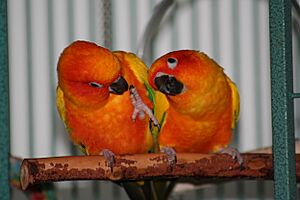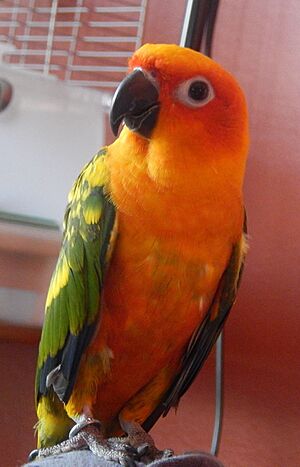Sun conure facts for kids
Quick facts for kids Sun conure |
|
|---|---|
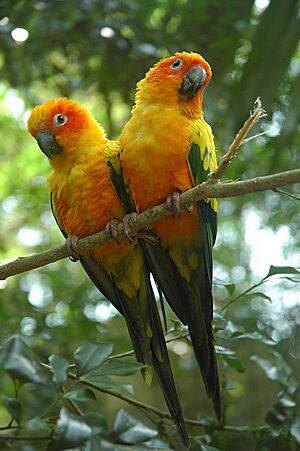 |
|
| Conservation status | |
| Scientific classification | |
| Genus: |
Aratinga
|
| Species: |
solstitialis
|
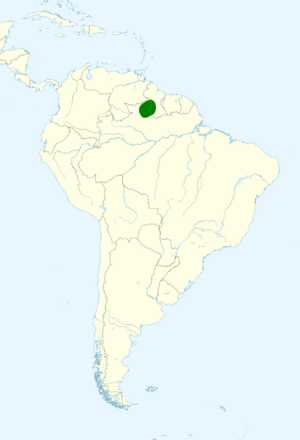 |
|
| Synonyms | |
|
|
The sun conure (Aratinga solstitialis), also called the sun parakeet, is a colorful, medium-sized parrot. It lives in northeastern South America. Adult male and female sun conures look very similar. They have black beaks and are mostly golden-yellow. Their bellies and faces are orange, and their wings and tails have green and blue tips.
Sun conures are very social birds. They usually live in large groups called flocks. For breeding, they form pairs that stay together for life. They build their nests in holes found in palm trees. Sun conures eat fruits, flowers, seeds, nuts, and insects. Many people keep these birds as pets. They can live for up to 30 years. Sadly, sun conures are now an endangered species. This is because their homes are disappearing. Also, too many are caught for their feathers or to be sold as pets.
Contents
What is a Sun Conure?
The sun conure was first described by a famous scientist named Carl Linnaeus in 1758. He gave it the name Psittacus solstitialis. Later, it was moved to a different group called Aratinga. This group includes many similar parrots from the Americas. The name solstitialis means 'of the summer solstice' in Latin. This refers to its bright, sunny, golden feathers.
People often call this bird either a "sun conure" or a "sun parakeet." Both names are correct. The sun conure is part of a group of four similar species from Brazil. These include the jandaya parakeet and the golden-capped parakeet. They all look a bit alike. Scientists used to think they were all the same species. Now, most agree they are separate species.
The sun conure is also related to the Carolina parakeet, which is now extinct. Scientists have studied the sun conure's genes. This helps them learn more about the extinct Carolina parakeet. These two species shared a common ancestor about 3 million years ago.
Appearance
Sun conures usually weigh about 110 grams (4 ounces). They are about 30 centimeters (12 inches) long. Males and females have similar feathers. However, females might be a bit lighter and smaller. They may also have a shorter tail and a smaller, rounder head.
Adult sun conures have bright yellow feathers on their head, neck, back, and chest. Their face and belly are orange, with some red around their ears. Their wings have green, dark blue, and black feathers. Their tail is olive-green with a blue tip. Their beak is black. They have gray skin around their eyes. Young sun conures look mostly green. They get their bright yellow, orange, and red colors as they grow up.
Where They Live
Sun conures live in a small area of northeastern South America. This includes parts of northern Brazil, southern Guyana, Suriname, and French Guiana. They sometimes wander to other coastal areas.
These birds mostly live in tropical places. They are often found in dry woodlands and coastal forests. They also live at the edges of humid forests. Sun conures cross open grasslands when they fly between forest areas. They like to live in trees that have fruit and in palm groves.
Behavior
Like other Aratinga parrots, sun conures are very social. They usually live in large groups of 15 to 30 birds. They rarely leave their flock. If they get separated, they make loud, high-pitched calls. These calls can be heard far away. This helps them find their way back to their group.
Flocks are quiet when they are eating. But they are very noisy when they fly. They can travel many miles in a day. Sun conures are fast and fly in a straight line. They also use body language to communicate. Birds in a flock rest, feed each other, clean their feathers, and bathe. They use their beaks to help them climb through trees. They can also use their feet like hands to hold and eat things. Sun conures build their nests in holes in palm trees.
When they are losing old feathers (molting), conures can be uncomfortable. Bathing and warm rain help them feel better. Sun conures are very smart and curious. They need lots of things to keep their minds busy. They also need to interact with others. They can learn to talk a little and do tricks when kept as pets.
What They Eat
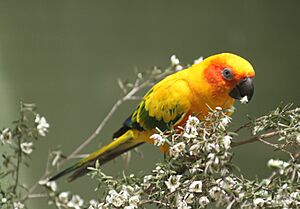
In the wild, sun conures mostly eat fruits, flowers, berries, seeds, nuts, and insects. They eat both ripe and unripe seeds from fruits and berries. They also eat red cactus fruit and certain berries. Sometimes, they eat crops from farms.
For pet sun conures, their diet can include grass seeds, beans, and nuts. They also eat many fruits like apples, bananas, and strawberries. Vegetables like spinach, carrots, and broccoli are good for them too. They can also eat dandelions and corn. Some owners give them hard-boiled eggs or cheese for protein. Things like cuttle bones and mineral blocks help them digest their food.
Life Cycle
Young sun conures form pairs when they are about 4 to 5 months old. Before they breed, they might feed and groom each other. Mating can last a few minutes. After mating, the pairs become very loving. The female's belly gets bigger before she lays eggs.
They nest in trees or in holes in palm trees. A female usually lays three or four white eggs. She lays them every two or three days. The female sits on the eggs for 23 to 27 days to keep them warm. She only leaves the nest for short times to eat. The male bird fiercely protects the nest from danger.
Chicks are born blind, naked, and helpless. After about 10 days, their eyes open. Both parents feed the chicks. The young birds depend on their parents for 7 to 8 weeks. They become independent after 9 to 10 weeks. Sun conures can start having their own babies when they are about 2 years old. They can live for 25 to 30 years.
Status
Sun conures are now an endangered species. Their numbers are dropping fast. This is because their homes are being destroyed. Also, many are hunted for their feathers. A huge number, about 800,000 each year, used to be caught from the wild to be sold as pets. Now, more sun conures live in homes than in the wild.
Laws have been made to help them. In 1992, the United States banned importing wild parrots. The European Union did the same in 2007. These laws help increase their numbers in the wild. In the past, sun conures were not considered at risk. But recent studies show they are rare in some areas where they used to be common. Because of this, their status was changed to "endangered" in 2008.
As Pets
Sun conures are known for their very loud calls. They can be louder than many bigger parrots. They can copy human sounds, but not as well as some other parrots. They are popular pets because of their bright colors and curious nature.
Because they are so curious, they need a lot of attention from their owners. They can be very loving and cuddly with people they know. But they might be aggressive with strangers. Sun conures can learn many tricks. They even enjoy listening to music and sometimes "sing" and "dance." Like many parrots, they love to chew. They need toys and treats to chew on. They also enjoy taking baths and cleaning their feathers.
Some owners trim their conures' wing feathers. This is not always needed if owners take proper safety steps. Sun conures should not fly around unsupervised because of dangers in the home. Well-trained sun conures can fly outdoors, but risks must be kept very low. In captivity, they usually live for 15 to 30 years.
A special "red-factor" color has been bred in pet sun conures. These birds have a deep reddish-orange color instead of yellow. This color can be different for each bird. Some very red birds can have health problems and may not live long.





